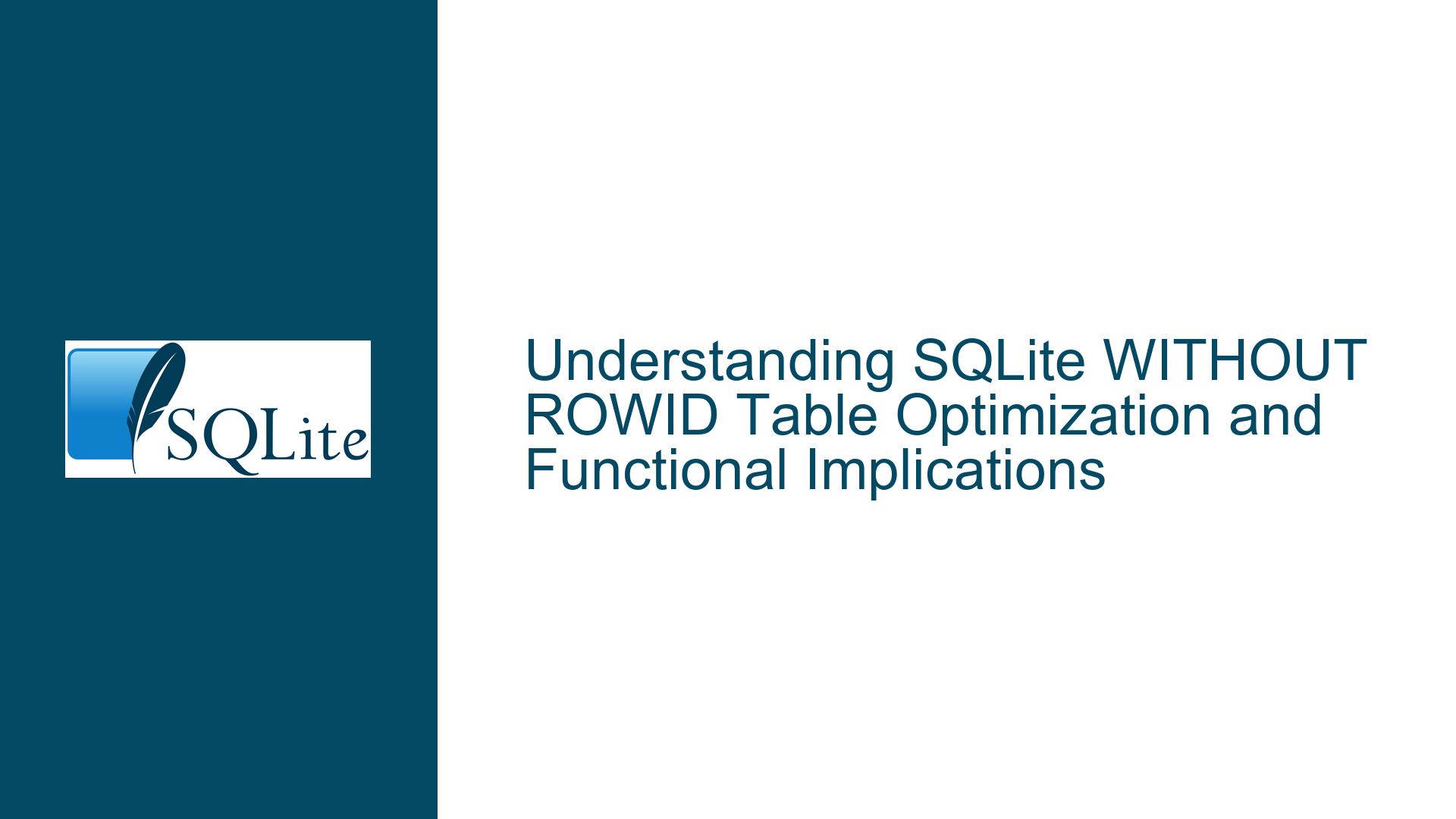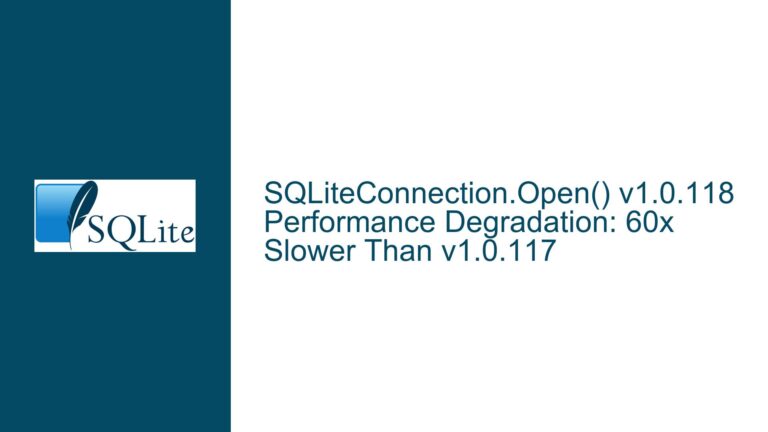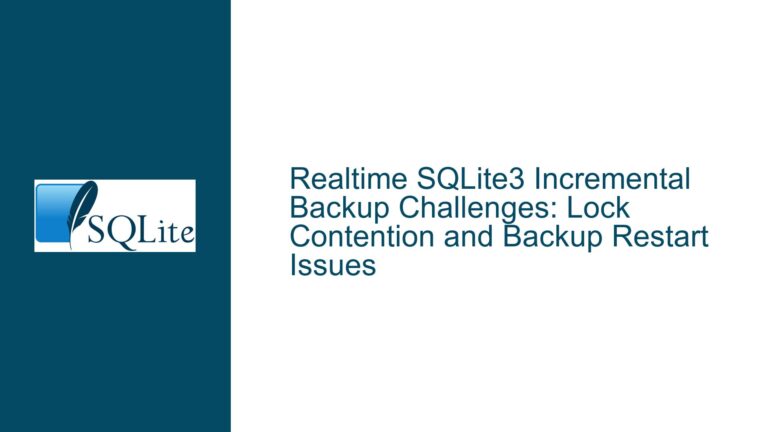SQLite WITHOUT ROWID Table Optimization and Functional Implications
SQLite WITHOUT ROWID Table Optimization and Functional Implications
The use of the WITHOUT ROWID clause in SQLite can significantly impact both the performance and storage efficiency of a database. However, it also introduces nuances that can affect the functional behavior of the database, particularly when migrating from a standard table schema to a WITHOUT ROWID schema. This post delves into the intricacies of this optimization, the potential pitfalls, and the steps to ensure a smooth transition.
SQLite Database Size Reduction and Performance Impact
The primary motivation behind using the WITHOUT ROWID clause is to optimize both the storage size and the performance of the database. In a standard SQLite table, each row is assigned a unique rowid, which serves as the primary key if no explicit primary key is defined. This rowid is stored as a 64-bit integer, and an implicit index is created to facilitate quick lookups based on this rowid. When a table is defined with an explicit primary key, SQLite still creates an implicit index for the primary key, leading to additional storage overhead.
In contrast, a WITHOUT ROWID table eliminates the rowid and uses the primary key directly as the storage key. This eliminates the need for the implicit index, resulting in a smaller database file and potentially faster lookups, especially for tables with a large number of rows. For example, in the case of the info table with 170,000 rows, the database size was reduced from approximately 6.95 MB to 3.87 MB after converting to a WITHOUT ROWID table.
However, this optimization comes with trade-offs. The absence of a rowid means that certain operations that rely on the rowid will no longer function as expected. For instance, queries that use rowid for filtering or ordering will fail in a WITHOUT ROWID table. Additionally, the last_insert_rowid() function, which returns the rowid of the most recently inserted row, will not return meaningful results for WITHOUT ROWID tables.
Interrupted Write Operations Leading to Index Corruption
One of the critical issues that can arise when transitioning to a WITHOUT ROWID table is the potential for database corruption, particularly during interrupted write operations. In a standard SQLite table, the rowid serves as a stable identifier for each row, which can help in recovering from interrupted operations. However, in a WITHOUT ROWID table, the primary key is used directly for storage, and any interruption during a write operation can lead to inconsistencies in the primary key index.
In the scenario described, the application appeared to go into a loop and resulted in a "database locked" error when attempting to access the AFTER database. This behavior is indicative of a potential issue with the primary key index in the WITHOUT ROWID table. When the database is locked, it suggests that a transaction was not properly committed or rolled back, leading to a state where the database is in an inconsistent state.
The reduction in database size and the potential for faster lookups are significant advantages of using WITHOUT ROWID tables. However, these benefits must be weighed against the risks of database corruption, particularly in environments where write operations may be interrupted, such as during power failures or application crashes.
Implementing PRAGMA journal_mode and Database Backup Strategies
To mitigate the risks associated with WITHOUT ROWID tables, it is essential to implement robust database backup strategies and configure the SQLite database to use an appropriate journal mode. The PRAGMA journal_mode setting determines how SQLite handles transaction logging, which is crucial for recovering from interrupted operations.
One of the most effective journal modes for ensuring data integrity is WAL (Write-Ahead Logging). In WAL mode, changes to the database are first written to a separate log file before being applied to the main database file. This allows for concurrent read and write operations and provides a mechanism for recovering from interrupted transactions. To enable WAL mode, the following command can be executed:
PRAGMA journal_mode=WAL;
In addition to configuring the journal mode, it is crucial to implement a regular backup strategy for the SQLite database. SQLite provides the VACUUM command, which can be used to rebuild the database file, effectively defragmenting it and ensuring that all data is stored in a consistent state. The VACUUM command can be executed as follows:
VACUUM;
Furthermore, it is advisable to create periodic backups of the database file, especially before making significant changes such as converting a table to a WITHOUT ROWID schema. This can be done using the .backup command in the SQLite CLI:
.backup main backup.db
By combining these strategies, the risks associated with WITHOUT ROWID tables can be significantly reduced, ensuring that the database remains consistent and recoverable even in the event of interrupted operations.
Conclusion
The use of WITHOUT ROWID tables in SQLite offers significant advantages in terms of storage efficiency and performance. However, it also introduces potential pitfalls, particularly in environments where write operations may be interrupted. By understanding the implications of this optimization and implementing robust backup and recovery strategies, it is possible to leverage the benefits of WITHOUT ROWID tables while minimizing the risks.
In summary, the transition to a WITHOUT ROWID schema should be approached with caution, particularly in environments where data integrity is critical. By configuring the appropriate journal mode, regularly backing up the database, and understanding the limitations of WITHOUT ROWID tables, it is possible to achieve a balance between performance optimization and data reliability.






